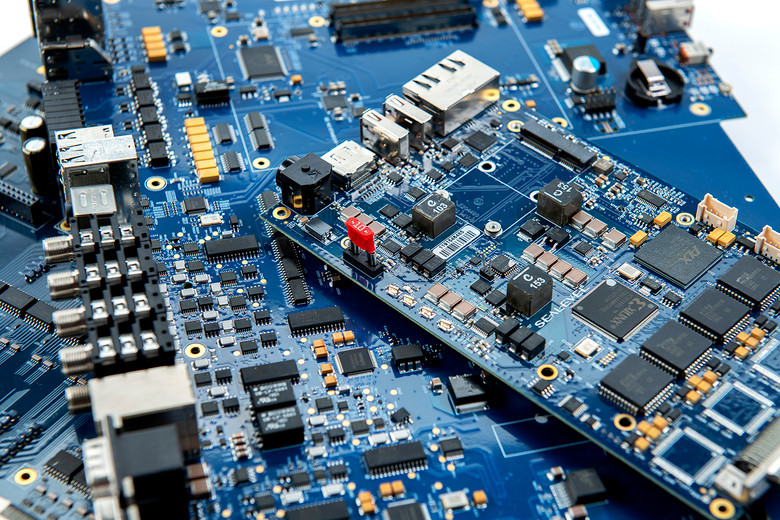COM-HPC or COM Express: Which Architecture Should You Choose?

COM-HPC is a computer-on-module (COM) specification for high-performance computing (HPC) defined by the PCI Industrial Computer Manufacturers Group (PICMG). PICMG is a non-profit consortium of companies and organizations that have come together to develop open standards for various applications, from high-performance telecommunications to military, industrial, and general-purpose embedded computing.
Much like COM Express, COM-HPC is a two-board architecture consisting of a standardized computing module that contains the processor, memory, and other core logic and a customizable carrier board designed to meet the application’s I/O or subsystem requirements. A module connector physically attaches the module to the board and provides high-speed, high-pin-count signaling between the module and carrier board.
The modular design streamlines the development of custom hardware while ensuring the upgradability of the processor and memory subsystems. This two-board, modular design methodology is proven by the longstanding success of COM Express, a specification ratified by PICMG in 2005.
While the two specifications share many characteristics, COM-HPC demonstrates the advancement of open standards technology. COM-HPC modules are intended to offer even greater performance than existing COM standards.
COM Express:
- Processor Compatibility: Supports a wide range of processors, including high-end Intel® and AMD CPUs.
- Memory: Supports up to DDR4 memory.
- Connectivity: Includes PCIe Gen 3, USB 3.0, and Gigabit Ethernet.
- Power Consumption: Supports lower power consumption than COM-HPC, and is suitable for embedded applications.
- Networking: Limited to Gigabit Ethernet, suitable for industrial and embedded applications.
- I/O: Provides a balanced range of I/O options, but fewer PCIe lanes and lower-speed interfaces compared to COM-HPC.
COM-HPC
- Processor Compatibility: Supports high-performance processors, including server-grade CPUs with multiple cores.
- Memory: Allows higher memory bandwidth and capacity, with support for DDR4 and future DDR5 memory.
- Connectivity: Provides advanced connectivity options, including PCIe Gen 4 (and future Gen 5), high-speed Ethernet (up to 25 GbE), and multiple USB4 ports.
- Power Consumption: Designed to handle higher power consumption, supporting up to 300W.
- Networking: Supports high-speed networking interfaces suitable for data centers and edge computing.
- I/O: Provides a wide range of I/O interfaces, including numerous PCIe lanes, multiple Ethernet ports, and USB interfaces.
COM-HPC Applications
COM-HPC is more appropriate for applications that require extreme processing power, high data throughput, and advanced connectivity which can exceed the capabilities of even high-end COM Express modules.
Deploying AI to process data in real-time, such as in smart cities, autonomous vehicles, and industrial automation, requires a large amount of power. The need for high computational power and low latency, along with support for high-bandwidth memory and fast data transfer, makes COM-HPC ideal for running complex AI models and real-time analytics.
The development of high-density data processing units, or specialized computing nodes for data centers is another application that is much better suited for COM-HPC. The ability to handle high-end server-grade processors, high memory capacity, and extensive I/O options makes COM-HPC modules suitable for compact, energy-efficient server designs in cloud and data center applications.
COM-HPC systems are already being used in advanced medical imaging systems, such as MRI, CT scans, or 3D ultrasound. These applications require intense parallel processing power and high data throughput for real-time image processing and analysis, which COM-HPC can provide thanks to its support for multi-core processors and high-speed interfaces.
High-performance AR/VR systems for training, gaming, or simulation applications are also already seeing COM-HPC systems being deployed. In this case, the need for high graphics processing power, low latency, and high data throughput to handle complex 3D graphics and real-time processing makes COM-HPC a suitable choice.
COM Express Applications
There are many applications where a COM Express approach is more appropriate than COM-HPC. In general, COM Express is much better suited for use cases that prioritize power efficiency, cost-effectiveness, and integrations that are a part of well-established ecosystems, while still requiring solid performance and a balanced range of I/O options.
Since the inception of the COM Express architecture, industrial automation and control system applications have been among the most prevalent use cases. These systems require reliable, long-life components with moderate processing power and a variety of I/O interfaces. COM Express offers proven solutions with lower power consumption and the performance to handle most industrial automation tasks.
COM Express systems also see heavy usage in transportation systems. These applications include in-vehicle computing and infotainment systems for trains, buses, and trucks. The need for robust, energy-efficient, and cost-effective solutions that can withstand harsh environmental conditions makes COM Express a more suitable choice for embedded systems in transportation.
One of the most significant benefits that a COM Express architecture provides is the ability to ruggedize systems to withstand high-shock and/or high-vibration environments. Carrier boards can be designed to the exact footprint dimensions to allow I/O connectors to be soldered directly to the board, eliminating internal cables. Further, COM Express systems can be designed to operate without fans, using low-power processors, which is ideal for aerospace and military applications requiring both ruggedization and SWaP-C2 optimization.
COM Express is the preferred architecture in applications where power efficiency, cost-effectiveness, and a wide range of I/O are more important than cutting-edge performance. It is ideal for many different embedded and industrial applications, transportation systems, military and aerospace systems, and other use cases where the performance offered by COM-HPC would be unnecessary and potentially overkill. The mature ecosystem, broad adoption, and proven reliability of COM Express make it an ideal choice for most embedded computing applications.
Categories:
